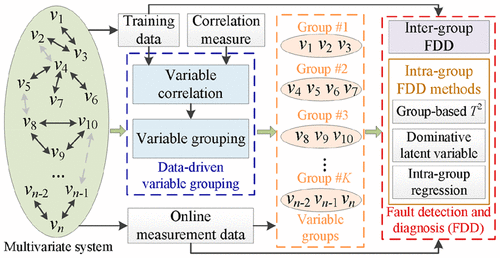当前位置:
X-MOL 学术
›
Ind. Eng. Chem. Res.
›
论文详情
Our official English website, www.x-mol.net, welcomes your feedback! (Note: you will need to create a separate account there.)
Multivariate Fault Detection and Diagnosis Based on Variable Grouping
Industrial & Engineering Chemistry Research ( IF 4.2 ) Pub Date : 2020-03-31 , DOI: 10.1021/acs.iecr.0c00192 Lijia Luo 1 , Jinpeng Wang 1 , Chudong Tong 2 , Junwei Zhu 3
Industrial & Engineering Chemistry Research ( IF 4.2 ) Pub Date : 2020-03-31 , DOI: 10.1021/acs.iecr.0c00192 Lijia Luo 1 , Jinpeng Wang 1 , Chudong Tong 2 , Junwei Zhu 3
Affiliation

|
In a traditional fault detection and diagnosis (FDD) scheme, all of variables in a multivariate system are examined together as a single group. This FDD scheme may suffer from the amplification and masking effects that are caused by introducing fault-free variables in the fault detection index, especially for a multivariate system with a large number of variables. To overcome this problem, a new FDD scheme for multivariate systems is developed using variable grouping. First, a data-driven variable grouping algorithm is proposed to divide system variables into groups. The optimal variable grouping is obtained by maximizing variable correlations within groups but minimizing variable correlations among groups. Then, a multigroup FDD scheme is developed, consisting of an intergroup FDD method and three intragroup FDD methods, called the group-based T2 method, the dominative latent variable method, and the intragroup regression method, respectively. Because each group consists of a few closely correlated variables, the fault detection index in every group can reduce the amplification and masking effects caused by redundant variables. This makes the fault detection index more sensitive to faults occurred in variable groups, and, hence, fault detection performance is improved. Moreover, the multigroup FDD scheme can clearly reveal the faulty groups in which faults occurred and the major contributing variables in the faulty groups. This facilitates the diagnosis of faults. The advantages of the multigroup FDD scheme are demonstrated with two case studies.
中文翻译:

基于变量分组的多元故障检测与诊断
在传统的故障检测和诊断(FDD)方案中,将多变量系统中的所有变量作为一个组一起进行检查。这种FDD方案可能会遭受由于在故障检测指标中引入无故障变量而引起的放大和屏蔽效应,尤其是对于具有大量变量的多变量系统而言。为了克服这个问题,使用变量分组为多变量系统开发了一种新的FDD方案。首先,提出了一种数据驱动的变量分组算法,将系统变量分为几组。通过最大化组内的变量相关性但最小化组间的变量相关性来获得最佳变量分组。然后,开发了一种多组FDD方案,该方案由组间FDD方法和三种组内FDD方法组成,称为基于组T 2方法,优势潜变量方法和组内回归方法。因为每个组都包含一些紧密相关的变量,所以每个组中的故障检测指标都可以减少由冗余变量引起的放大和掩盖效应。这使得故障检测指标对可变组中发生的故障更加敏感,因此,提高了故障检测性能。此外,多组FDD方案可以清楚地显示发生故障的故障组以及故障组中的主要贡献变量。这有助于故障诊断。通过两个案例研究证明了多组FDD方案的优势。
更新日期:2020-04-24
中文翻译:

基于变量分组的多元故障检测与诊断
在传统的故障检测和诊断(FDD)方案中,将多变量系统中的所有变量作为一个组一起进行检查。这种FDD方案可能会遭受由于在故障检测指标中引入无故障变量而引起的放大和屏蔽效应,尤其是对于具有大量变量的多变量系统而言。为了克服这个问题,使用变量分组为多变量系统开发了一种新的FDD方案。首先,提出了一种数据驱动的变量分组算法,将系统变量分为几组。通过最大化组内的变量相关性但最小化组间的变量相关性来获得最佳变量分组。然后,开发了一种多组FDD方案,该方案由组间FDD方法和三种组内FDD方法组成,称为基于组T 2方法,优势潜变量方法和组内回归方法。因为每个组都包含一些紧密相关的变量,所以每个组中的故障检测指标都可以减少由冗余变量引起的放大和掩盖效应。这使得故障检测指标对可变组中发生的故障更加敏感,因此,提高了故障检测性能。此外,多组FDD方案可以清楚地显示发生故障的故障组以及故障组中的主要贡献变量。这有助于故障诊断。通过两个案例研究证明了多组FDD方案的优势。



























 京公网安备 11010802027423号
京公网安备 11010802027423号